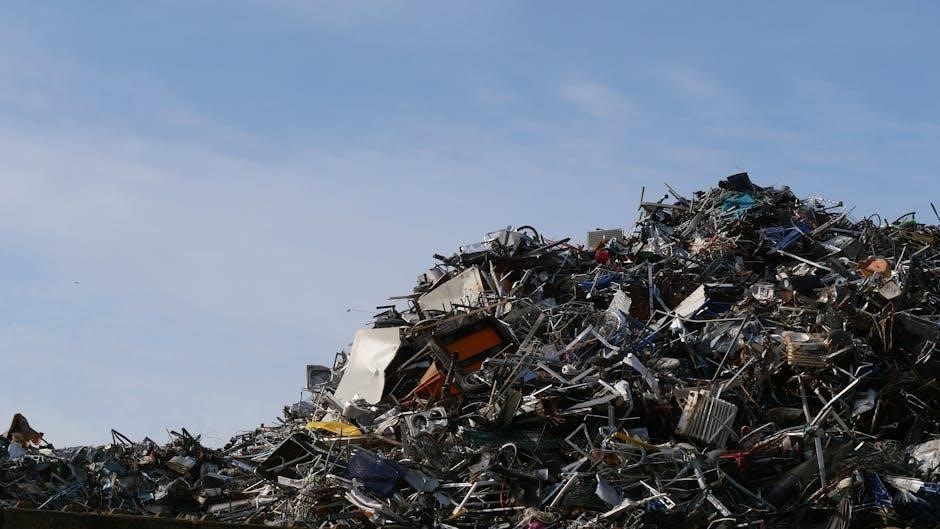Manually lowering a dump trailer involves specific steps, especially when the hydraulic system fails. This process ensures safety and prevents damage. Understanding the procedure allows operators to handle emergencies effectively and return the trailer to service.
Importance of Safety and Preparation
Safety is paramount when manually lowering a dump trailer due to potential hazards. Begin by ensuring the trailer is on a level surface to prevent uncontrolled movement. Clear the area of personnel and obstacles to avoid injuries or damage. Thoroughly inspect the surroundings for potential risks like overhead power lines. Wear appropriate personal protective equipment, including gloves and safety glasses. Review the trailer’s manual for specific safety guidelines and recommended procedures. Proper preparation minimizes the risk of accidents and ensures a controlled and safe lowering process, protecting both the operator and the equipment from potential harm during manual intervention.
Understanding Dump Trailer Components
A crucial aspect of safely operating and maintaining a dump trailer is understanding its key components. This includes the hydraulic system, axles, tires and the trailer’s frame. Regular inspections are key.
Hydraulic System Overview
The hydraulic system is central to the operation of a dump trailer, enabling the raising and lowering of the trailer bed. This system comprises a hydraulic pump, a cylinder, hoses, and a control valve. The pump generates the pressure, while the cylinder extends and retracts to lift or lower the bed. Hoses transport the hydraulic fluid, and the control valve regulates the fluid flow. Regular maintenance is vital for optimal performance and safety, including checking for leaks and ensuring proper fluid levels. Understanding each part ensures correct use.
Pre-Lowering Checks and Preparations
Before manually lowering a dump trailer, inspect the area for obstacles and ensure a stable, level surface. Verify that the trailer is not overloaded and that all safety protocols are followed closely.
Ensuring a Safe Environment
Creating a safe environment is paramount before manually lowering a dump trailer. Begin by parking the trailer on a firm, level surface to prevent unexpected movement. Clear the surrounding area of all personnel and obstructions, ensuring ample space to work safely. Check for overhead power lines or other hazards that could pose a risk during the lowering process. Secure the wheels with chocks to stabilize the trailer and prevent rolling. Wear appropriate personal protective equipment, including gloves and eye protection, to minimize potential injuries. Effective communication among team members is essential to coordinate efforts and avoid accidents.

Step-by-Step Guide to Manual Lowering
Manually lowering a dump trailer requires careful execution. This involves releasing hydraulic pressure and using manual override options. Follow each step meticulously to ensure safe and controlled lowering of the trailer bed.
Releasing Hydraulic Pressure
Releasing hydraulic pressure is a critical step in manually lowering a dump trailer. Start by locating the hydraulic pump and valve system, usually near the trailer’s frame. Ensure the area around the valve is clear of any obstructions or personnel. Use appropriate tools to carefully open the release valve. Slowly release the pressure, monitoring the trailer bed’s movement. Avoid rapid release, as this can cause damage or uncontrolled descent. If equipped, utilize a pressure gauge to control the release. Once pressure is fully released, proceed to manual override if necessary, ensuring a smooth and safe lowering process.
Using Manual Override Options
After releasing hydraulic pressure, engage the manual override options to lower the dump trailer. Identify the manual crank or lever, typically located near the hydraulic pump. Attach the crank handle securely and begin turning it slowly and steadily. Monitor the trailer bed’s descent, ensuring it lowers evenly. If resistance is encountered, inspect for obstructions or uneven weight distribution. Continue cranking until the trailer bed is fully lowered and secured. Always use caution and avoid forcing the mechanism. Refer to the trailer’s manual for specific instructions and safety guidelines related to the manual override system.
Troubleshooting Common Issues
When manually lowering a dump trailer, issues can arise. Addressing these problems promptly is crucial for safe operation. This section offers guidance on diagnosing and resolving common issues during the manual lowering process.
Trailer Not Lowering
If the dump trailer fails to lower manually, several factors could be responsible. First, check if the hydraulic pressure has been fully released. Verify the manual override valve is engaged correctly, ensuring proper flow. Obstructions in the cylinder or hose can also prevent lowering. Examine the system for visible damage or leaks that impede hydraulic function. Confirm the dump valve operation. Ensure the area is clear of obstructions, and the trailer is on level ground. If problems persist, consult a qualified technician for further inspection.
Post-Lowering Safety Checks
After manually lowering, inspect the trailer. Ensure the bed is fully down and secured. Check hydraulic lines for leaks. Verify all safety mechanisms are engaged. Confirm the trailer is stable before transport.
Securing the Trailer
Once the dump trailer is lowered manually, securing it properly is paramount to prevent accidents. Engage the parking brakes firmly to ensure the trailer cannot roll. Use wheel chocks on both sides of the tires, especially if the ground isn’t level. Inspect the locking mechanisms for the dump bed to confirm they are fully engaged. Lower the landing gear to eliminate any gap between the ground and the landing gear foot, if equipped. Double-check all connections and latches to guarantee everything is secure before moving the tow vehicle. Ensure all safety measures are in place.

Regular Maintenance for Hydraulic Systems
Maintaining the hydraulic system is crucial for dump trailer functionality. Routine checks prevent failures and extend the lifespan of components. Proper maintenance ensures smooth operation and reduces the need for manual lowering procedures.
Inspecting for Leaks and Damage
Regularly inspect the hydraulic system for leaks around hoses, cylinders, and fittings. Check for any signs of physical damage, such as dents or cracks, on hydraulic components. Look for corrosion or rust, which can weaken the system over time, leading to potential failures. Pay close attention to hose conditions, ensuring they aren’t frayed or worn. Replace any damaged parts immediately to prevent further issues. Verify that all connections are tight and secure to maintain proper pressure. Address any minor issues promptly to avoid major repairs and ensure safe, reliable operation of the dump trailer’s hydraulic system.

Common Mistakes to Avoid
Avoid overloading the trailer beyond its capacity. Ensure the trailer is on level ground. Neglecting these precautions can lead to instability. Failing to properly secure the load risks potential accidents and damage.
Overloading and Uneven Surfaces
Overloading a dump trailer places excessive stress on the hydraulic system, potentially leading to malfunctions. This is particularly critical when attempting to manually lower the trailer, as the manual mechanisms might not be designed for such heavy loads. Always adhere to the trailer’s specified weight limits to prevent damage and ensure safe operation. Similarly, parking or operating a dump trailer on uneven surfaces can create instability, making it difficult to control the lowering process. The uneven distribution of weight can further strain the manual lowering system, increasing the risk of accidents and injuries. Level ground is essential for safe manual lowering.

Additional Safety Considerations
Beyond the core steps, consider tire pressure and condition. Ensure proper lighting and visibility during the lowering process. Always maintain a safe distance from the trailer and be aware of surroundings.
Tire Pressure and Condition
Before initiating any lowering procedure, meticulously inspect the tires. Correct tire pressure is crucial for stability and preventing blowouts. Consult the trailer’s manual for the recommended PSI. While checking pressure, look for any signs of damage, such as cuts, bulges, or uneven wear. Compromised tires can lead to dangerous situations during or after lowering. Ensure that all tires are in good condition and properly inflated. Replace any questionable tires before proceeding. Proper tire maintenance contributes significantly to overall safety and stability when handling a dump trailer, especially during manual operations.
